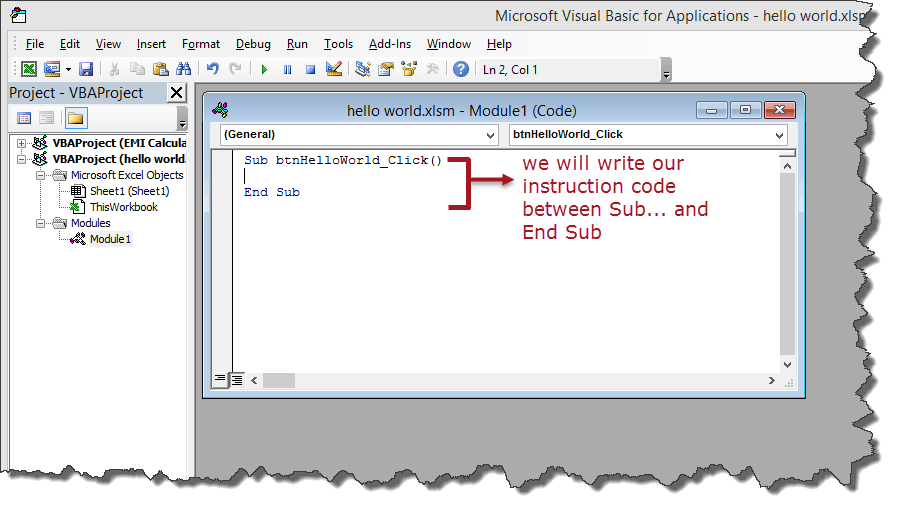The following console program is the Visual Basic version of the traditional 'Hello, World!' program, which displays the string 'Hello, World!'.
The important points of this program are the following:
- How To Code In Visual Basic
- Visual Basic Hello World Program
- Visual Studio Code Hello World
- Simple Visual Basic Code
- Comments
- The Main procedure
- Input and output
- Compilation and execution
All our examples shows the ASP code in red. VBScript is a light version of Microsoft's Visual Basic. The following example also writes 'Hello World' into HTML. This example introduces you to the basic functionality of VS Code by demonstrating how to write a 'hello world' program in C. Before continuing, make sure you have the 'ms-vscode.cpptools' extension installed. Initialize the Project. The first step is to create a new project. To do this, load the VS Code. A simple application written in F# that prints Hello, World! Download and install To start building.NET apps, download and install the.NET SDK (Software Development Kit).
The main ProcedureIn this chapter, we will create, compile, and run a simple “Hello World” program written in Visual Basic.NET. The analysis of this brief program will introduce key features of the Visual Basic.NET language. Example 2-1 illustrates the fundamental elements of a very simple Visual Basic.NET program. Will appear in the console.-Congradulations youve just created you first VC application. This is the simplest it gets. You have to read more, study other peoples code etc to become good in programming.
Every Visual Basic application must contain a procedure called Main. This procedure serves as the starting point and overall control for your application. It is called when your module is loaded.
There are four varieties of
 Main:
Main:- Sub Main()
- Sub Main(ByVal cmdArgs() As String)
- Function Main() As Integer
- Function Main(ByVal cmdArgs() As String) As Integer
To compile and run the program from the IDE

- Create a Visual Basic console application project.
- Copy the code into the project.
- Choose the appropriate Build command from the Build menu, or press F5 to build and run (corresponding to Start in the Debug menu).
Example
This example introduces you to the basic functionality of VS Code by demonstrating how to write a 'hello world' program in C++. Before continuing, make sure you have the 'ms-vscode.cpptools' extension installed.
How To Code In Visual Basic
Initialize the Project

The first step is to create a new project. To do this, load the VS Code program. You should be greeted with the typical welcome screen:
To create the first program, select 'Start' > 'New file' from the welcome screen. This will open a new file window. Go ahead and save the file ('File' > 'Save') into a new directory. You can name the directory anything you want, but this example will call the directory 'VSC_HelloWorld' and the file 'HelloWorld.cpp'.
Now write the actual program (feel free to copy the below text):
Great! You'll also notice that because you've installed the 'ms-vscode.cpptools' extension you also have pretty code-highlighting. Now let's move on to running the code.
Visual Basic Hello World Program
Running the Script (basic)
We can run 'HelloWorld.cpp' from within VS Code itself. The simplest way to run such a program is to open the integrated terminal ('View' > 'Integrated Terminal'). This opens a terminal window in the lower portion of the view. From inside this terminal we can navigate to our created directory, build, and execute the script we've written. Here we've used the following commands to compile and run the code:
Notice that we get the expected Hello World! output.
Running the Script (slightly more advanced)
Great, but we can use VS Code directly to build and execute the code as well. For this, we first need to turn the 'VSC_HelloWorld' directory into a workspace. This can be done by:
- Opening the Explorer menu (top most item on the vertical menu on the far left)
- Select the Open Folder button
- Select the 'VSC_HelloWorld' directory we've been working in. Note: If you open a directory within VS Code (using 'File' > 'Open...' for example) you will already be in a workspace.

The Explorer menu now displays the contents of the directory.

Next we want to define the actual tasks which we want VS Code to run. To do this, select 'Tasks' > 'Configure Default Build Task'. In the drop down menu, select 'Other'. This opens a new file called 'tasks.json' which contains some default values for a task. We need to change these values. Update this file to contain the following and save it:
Note that the above also creates a hidden .vscode directory within our working directory. This is where VS Code puts configuration files including any project specific settings files. You can find out more about Taskshere.
Visual Studio Code Hello World
In the above example, ${workspaceRoot} references the top level directory of our workspace, which is our 'VSC_HelloWorld' directory. Now, to build the project from inside the method select 'Tasks' > 'Run Build Task...' and select our created 'build' task and 'Continue without scanning the task output' from the drop down menus that show up. Then we can run the executable using 'Tasks' > 'Run Task...' and selecting the 'run' task we created. If you have the integrated terminal open, you'll notice that the 'Hello World!' text will be printed there.
It is possible that the terminal may close before you are able to view the output. If this happens you can insert a line of code like this int i; std::cin >> i; just before the return statement at the end of the main() function. You can then end the script by typing any number and pressing <Enter>.
And that's it! You can now start writing and running your C++ scripts from within VS Code.